Correlation between Fatigue Crack Growth Behavior and Fracture Surface Roughness on Cold-Rolled Austenitic Stainless Steels in Gaseous Hydrogen
Abstract
:1. Introduction
2. Materials and Experimental Procedures
2.1. Materials
2.2. Fatigue Crack Growth Tests
2.3. Roughness Measurement and Martensite Detection
2.4. Microstructural Observation
3. Results
3.1. Microstructural Observation
3.2. FCGRs and Roughness Measurement
3.2.1. Hydrogen Effect
3.2.2. Cold-Rolling Effect
3.3. Martensite Distribution on the Fatigue Fractured Surface
3.4. SEM Fractogragh of the Fatigue Fractured Surface
3.5. EBSD Analysis on the Fatigue Crack Path
4. Discussion
4.1. The Effect of Cold Rolling on the FCG Mechanism of ASSs
4.2. The Effect of Hydrogen on the FCG Mechanism of ASSs
5. Conclusions
- (1)
- The degrees of strain-induced martensite transformation in descending order were 301 > 304L > 310S if cold rolling was applied. Regardless of the testing conditions, the FCGRs and FSR of all specimens increased with increasing ∆K. This indicated that a larger plastic zone size led to a greater amount of martensite which resulted in higher FSR.
- (2)
- The 310S, a stable ASS, showed that the FCGRs and FSR were less affected by cold rolling and hydrogen embrittlement. In contrast with 301 and 304L SSs, the 310S specimen with a coarse grain size showed a much higher FSR and a tortuous crack path which was the result of the interaction of the crack growth with the slip bands, induced by fatigue strain.
- (3)
- For the unstable ASSs, such as 301 and 304L, cold rolling caused the formation of interlaced slip bands and induced martensite. The fatigue strain further enhanced slip processes and martensitic transformation ahead of the fatigue crack. The premature cracking of brittle martensite at the crack tip led to an increased FCGRs and a straightforward fatigue crack path.
- (4)
- The interaction of hydrogen with grain boundary martensite caused a hydrogen-accelerated FCG and intergranular fracture in the 301 ASS, which was associated with a high FSR. Thus, the high FSR might be used as an indicator of hydrogen-accelerated FCG in unstable ASSs.
Author Contributions
Conflicts of Interest
Abbreviations
| ASSs | Austenitic stainless steels |
| HE | Hydrogen embrittlement |
| FCGRs | Fatigue crack growth rates |
| COD | Crack opening displacement |
| SHPM | Scanning Hall probe microscope |
| FSR | Fracture surface roughness |
| FCG | Fatigue crack growth |
| EBSD | Electron back-scattered diffraction |
| SA | Solution-annealed |
| CR | Cold-rolled |
| CT | Compact tension |
| OM | Optical microscope |
| SEM | Scanning electron microscope |
| IPF | Inverse pole figure |
References
- Datta, K.; Delhez, R.; Bronsveld, P.M.; Beyer, J.; Geijselaers, H.J.M.; Post, J. A low-temperature study to examine the role of ε-martensite during strain-induced transformations in metastable austenitic stainless steels. Acta Mater. 2009, 57, 3321–3326. [Google Scholar] [CrossRef]
- Perdahcıoğlu, E.S.; Geijselaers, H.J.M.; Groen, M. Influence of plastic strain on deformation-induced martensitic transformations. Scr. Mater. 2008, 58, 947–950. [Google Scholar] [CrossRef]
- Gey, N.; Petit, B.; Humbert, M. Electron backscattered diffraction study of ε/α′ martensitic variants induced by plastic deformation in 304 stainless steel. Metall. Mater. Trans. A 2005, 36, 3291–3299. [Google Scholar] [CrossRef]
- Okayasu, M.; Fukui, H.; Ohfuji, H.; Shiraishi, T. Strain-induced martensite formation in austenitic stainless steel. J. Mater. Sci. 2013, 48, 6157–6166. [Google Scholar] [CrossRef]
- Da Rocha, M.R.; de Oliveira, C.A.S. Evaluation of the martensitic transformations in austenitic stainless steels. Mater. Sci. Eng. A 2009, 517, 281–285. [Google Scholar] [CrossRef]
- Tamura, I. Deformation-induced martensitic transformation and transformation-induced plasticity in steels. Met. Sci. 1982, 16, 245–253. [Google Scholar] [CrossRef]
- Bak, H.S.; Abro, A.M.; Lee, B.D. Effect of hydrogen and strain-induced martensite on mechanical properties of AISI 304 stainless steel. Metals 2016, 6, 169. [Google Scholar] [CrossRef]
- Böhner, A.; Niendorf, T.; Amberger, D.; Höppel, H.W.; Göken, M.; Maier, H.J. Martensitic transformation in ultrafine-grained stainless steel AISI 304L under monotonic and cyclic loading. Metals 2012, 2, 56–64. [Google Scholar] [CrossRef]
- Tian, Y.; Lienert, U.; Borgenstam, A.; Fischer, T.; Hedström, P. Martensite formation during incremental cooling of Fe-Cr-Ni alloys: An in-situ bulk X-ray study of the grain-averaged and single-grain behavior. Scr. Mater. 2017, 136, 124–127. [Google Scholar] [CrossRef]
- Tian, Y.; Gorbatov, O.I.; Borgenstam, A.; Ruban, A.V.; Hedström, P. Deformation microstructure and deformation-induced martensite in austenitic Fe-Cr-Ni alloys depending on stacking fault energy. Metall. Mater. Trans. A 2017, 48, 1–7. [Google Scholar] [CrossRef]
- Angel, T. Formation of martensite in austenitic stainless steels. J. Iron Steel Inst. 1954, 177, 165–174. [Google Scholar]
- Hecker, S.S.; Stout, M.G.; Staudhammer, K.P.; Smith, J.L. Effects of strain state and strain rate on deformation-induced transformation in 304 stainless steel: Part I. Magnetic measurements and mechanical behavior. Metall. Trans. A 1982, 13, 619–626. [Google Scholar] [CrossRef]
- Murr, L.E.; Staudhammer, K.P.; Hecker, S.S. Effects of strain state and strain rate on deformation-induced transformation in 304 stainless steel: Part II. Microstructural study. Metall. Trans. A 1982, 13, 627–635. [Google Scholar] [CrossRef]
- Lichtenfeld, J.A.; VanTyne, C.J.; Mataya, M.C. Effect of strain rate on stress-strain behavior of alloy 309 and 304L austenitic stainless steel. Metall. Mater. Trans. A 2006, 37, 147–161. [Google Scholar] [CrossRef]
- Chen, X.; Wang, Y.; Gong, M.; Xia, Y. Dynamic behavior of SUS304 stainless steel at elevated temperatures. J. Mater. Sci. 2004, 39, 4869–4875. [Google Scholar] [CrossRef]
- Talonen, J.; Hänninen, H. Formation of shear bands and strain-induced martensite during plastic deformation of metastable austenitic stainless steels. Acta Mater. 2007, 55, 6108–6118. [Google Scholar] [CrossRef]
- Lee, W.-S.; Lin, C.-F. The morphologies and characteristics of impact-induced martensite in 304L stainless steel. Scr. Mater. 2000, 43, 777–782. [Google Scholar] [CrossRef]
- Talonen, J.; Hänninen, H.; Nenonen, P.; Pape, G. Effect of strain rate on the strain-induced γ → α′-martensite transformation and mechanical properties of austenitic stainless steels. Metall. Mater. Trans. A 2005, 36, 421–432. [Google Scholar] [CrossRef]
- Hedström, P.; Lindgren, L.E.; Almer, J.; Lienert, U.; Bernier, J.; Terner, M.; Odén, M. Load partitioning and strain-induced martensite formation during tensile loading of a metastable austenitic stainless steel. Metall. Mater. Trans. A 2009, 40, 1039–1048. [Google Scholar] [CrossRef]
- De Abreu, H.F.G.; de Carvalho, S.S.; de Lima Neto, P.; dos Santos, R.P.; Freire, V.N.; de Silva, P.M.O.; Tavares, S.S.M. Deformation induced martensite in an AISI 301LN stainless steel: Characterization and influence on pitting corrosion resistance. Mater. Res. 2007, 10, 359–366. [Google Scholar] [CrossRef]
- Mumtaz, K.; Takahashi, S.; Echigoya, J.; Zhang, L.; Kamada, Y.; Sato, M. Temperature dependence of martensitic transformation in austenitic stainless steel. J. Mater. Sci. Lett. 2003, 22, 423–427. [Google Scholar] [CrossRef]
- Byun, T.S.; Hashimoto, N.; Farrell, K. Temperature dependence of strain hardening and plastic instability behaviors in austenitic stainless steels. Acta Mater. 2004, 52, 3889–3899. [Google Scholar] [CrossRef]
- Perng, T.P.; Altstetter, C.J. Comparison of hydrogen gas embrittlement of austenitic and ferritic stainless steels. Metall. Trans. A 1987, 18, 123–134. [Google Scholar] [CrossRef]
- Tsay, L.W.; Chen, J.J.; Huang, J.C. Hydrogen-assisted fatigue crack growth of AISI 316L stainless steel weld. Corros. Sci. 2008, 50, 2973–2980. [Google Scholar] [CrossRef]
- Tsay, L.W.; Yu, S.C.; Huang, R.T. Effect of austenite instability on the hydrogen-enhanced crack growth of austenitic stainless steels. Corros. Sci. 2007, 49, 2973–2984. [Google Scholar] [CrossRef]
- Zhang, L.; Wen, M.; Imade, M.; Fukuyama, S.; Yokogawa, K. Effect of nickel equivalent on hydrogen gas embrittlement of austenitic stainless steels based on type 316 at low temperatures. Acta Mater. 2008, 56, 3414–3421. [Google Scholar] [CrossRef]
- Martin, M.; Weber, S.; Theisen, W.; Michler, T.; Naumann, J. Effect of alloying elements on hydrogen environment embrittlement of AISI type 304 austenitic stainless steel. Int. J. Hydrogen Energy 2011, 36, 15888–15898. [Google Scholar] [CrossRef]
- Kang, J.-H.; Noh, H.-S.; Kim, K.-M.; Lee, S.C.; Kim, S.-J. Modified Ni equivalent for evaluating hydrogen susceptibility of Cr-Ni based austenitic stainless steels. J. Alloys Compd. 2017, 696, 869–874. [Google Scholar] [CrossRef]
- Kanezaki, T.; Narazaki, C.; Mine, Y.; Matsuoka, S.; Murakami, Y. Effects of hydrogen on fatigue crack growth behavior of austenitic stainless steels. Int. J. Hydrogen Energy 2008, 33, 2604–2619. [Google Scholar] [CrossRef]
- Murakami, Y.; Matsuoka, S. Effect of hydrogen on fatigue crack growth of metals. Eng. Fract. Mech. 2010, 77, 1926–1940. [Google Scholar] [CrossRef]
- Mine, Y.; Narazaki, C.; Murakami, K.; Matsuoka, S.; Murakami, Y. Hydrogen transport in solution-treated and pre-strained austenitic stainless steels and its role in hydrogen-enhanced fatigue crack growth. Int. J. Hydrogen Energy 2009, 34, 1097–1107. [Google Scholar] [CrossRef]
- Chen, X.; Zhou, C.; Cai, X.; Zheng, J.; Zhang, L. Effects of external hydrogen on hydrogen transportation and distribution around the fatigue crack tip in type 304 stainless steel. J. Mater. Eng. Perform. 2017, 26, 4990–4996. [Google Scholar] [CrossRef]
- Chen, T.C.; Chen, S.T.; Tsay, L.W. The role of induced α′-martensite on the hydrogen-assisted fatigue crack growth of austenitic stainless steels. Int. J. Hydrogen Energy 2014, 39, 10293–10302. [Google Scholar] [CrossRef]
- Chen, T.C.; Chen, S.T.; Kai, W.; Tsay, L.W. The effect of phase transformation in the plastic zone on the hydrogen-assisted fatigue crack growth of 301 stainless steel. Mater. Charact. 2016, 112, 134–141. [Google Scholar] [CrossRef]
- Irwin, G.R. Linear fracture mechanics, fracture transition, and fracture control. Eng. Fract. Mech. 1968, 1, 241–257. [Google Scholar] [CrossRef]
- Réthoré, J.; Limodin, N.; Buffière, J.-Y.; Roux, S.; Hild, F. Three-dimensional analysis of fatigue crack propagation using X-ray tomography, digital volume correlation and extended finite element simulations. Procedia IUTAM 2012, 4, 151–158. [Google Scholar] [CrossRef]
- Tanabe, H.; Kida, K.; Takamatsu, T.; Itoh, N.; Santos, E.C. Observation of magnetic flux density distribution around fatigue crack and application to non-destructive evaluation of stress intensity factor. Procedia Eng. 2011, 10, 881–886. [Google Scholar] [CrossRef]
- Saka, M.; Sato, I.; Abé, H. NDE of a 3-D surface crack using magnetic field induced by DC current flow. NDT E Int. 1998, 31, 325–328. [Google Scholar] [CrossRef]
- Palumbo, D.; Ancona, F.; DeFinis, R.; Galietti, U. Experimental study of the crack growth in stainless steels using thermal methods. Procedia Eng. 2015, 109, 338–345. [Google Scholar] [CrossRef]
- Ancona, F.; DeFinis, R.; Palumbo, D.; Galietti, U. Crack growth monitoring in stainless steels by means of TSA technique. Procedia Eng. 2015, 109, 89–96. [Google Scholar] [CrossRef]
- Saxena, A.; Hudak, S.J., Jr. Review and extension of compliance information for common crack growth specimens. Int. J. Fract. 1978, 14, 453–468. [Google Scholar] [CrossRef]
- Haušild, P.; Davydov, V.; Drahokoupil, J.; Landa, M.; Pilvin, P. Characterization of strain-induced martensitic transformation in a metastable austenitic stainless steel. Mater. Des. 2010, 31, 1821–1827. [Google Scholar] [CrossRef]
- Talonen, J.; Aspegren, P.; Hänninen, H. Comparison of different methods for measuring strain induced α′-martensite content in austenitic steels. Mater. Sci. Technol. 2004, 20, 1506–1512. [Google Scholar] [CrossRef]
- Moallemi, M.; Kermanpur, A.; Najafizadeh, A.; Rezaee, A.; Baghbadorani, H.S.; Nezhadfar, P.D. Deformation-induced martensitic transformation in a 201 austenitic steel: The synergy of stacking fault energy and chemical driving force. Mater. Sci. Eng. A 2016, 653, 147–152. [Google Scholar] [CrossRef]
- Kisko, A.; Misra, R.D.K.; Talonen, J.; Karjalainen, L.P. The influence of grain size on the strain-induced martensite formation in tensile straining of an austenitic 15Cr-9Mn-Ni-Cu stainless steel. Mater. Sci. Eng. A 2013, 578, 408–416. [Google Scholar] [CrossRef]
- Yin, D.; Liu, H.; Chen, Y.; Yi, D.; Wang, B.; Wang, B.; Shen, F.; Fu, S.; Tang, C.; Pan, S. Effect of grain size on fatigue-crack growth in 2524 aluminium alloy. Int. J. Fatigue 2016, 84, 9–16. [Google Scholar] [CrossRef]
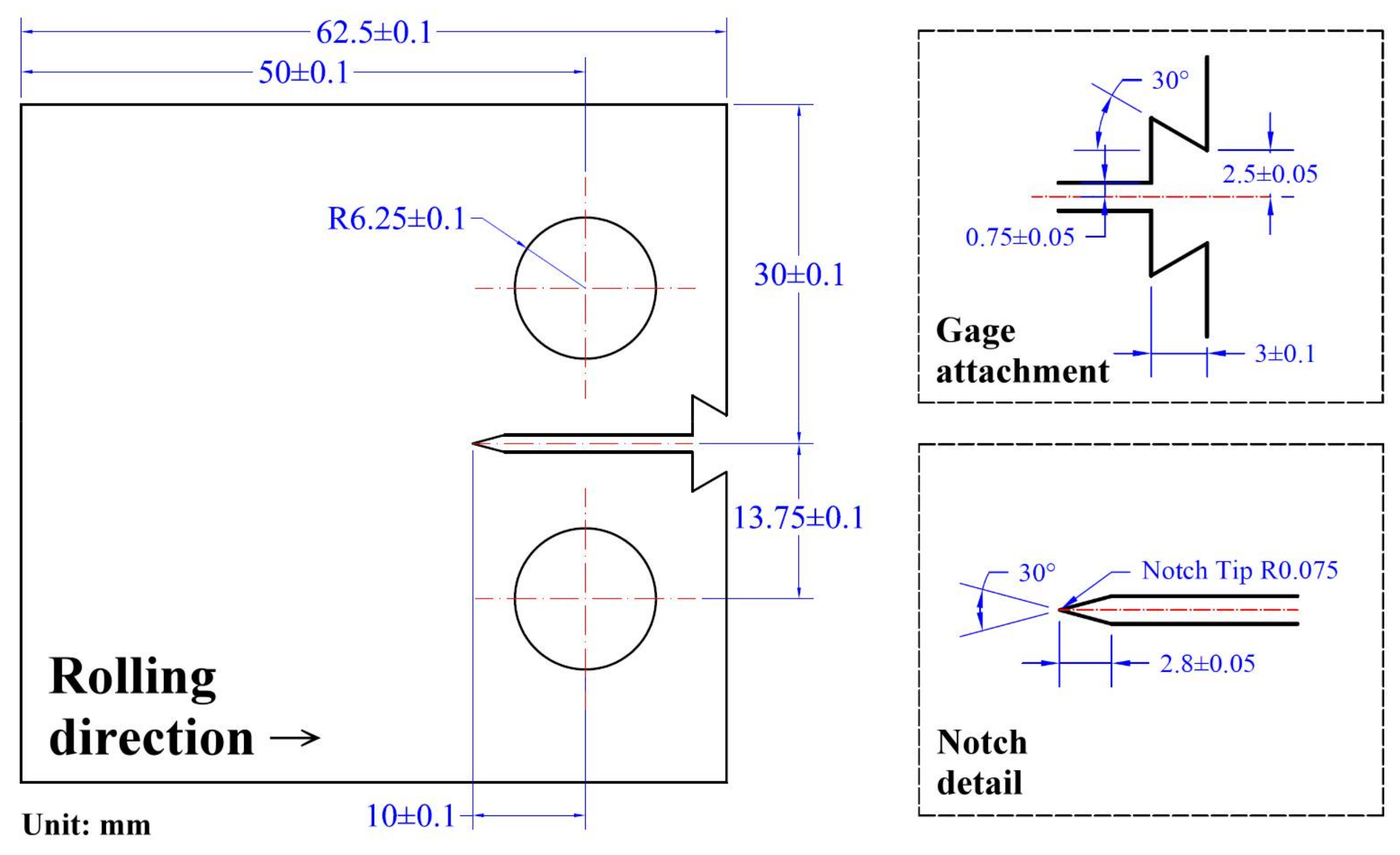


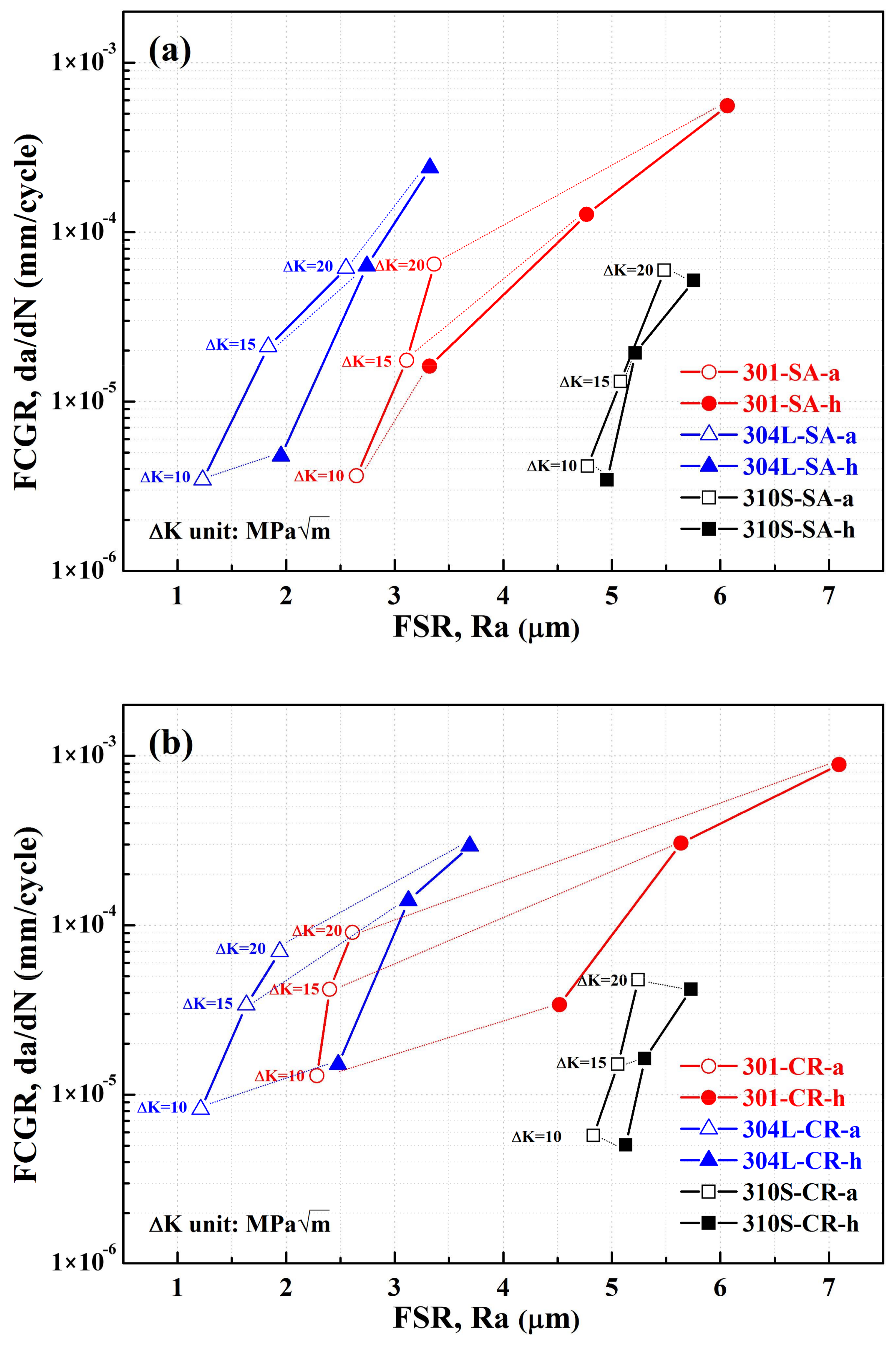
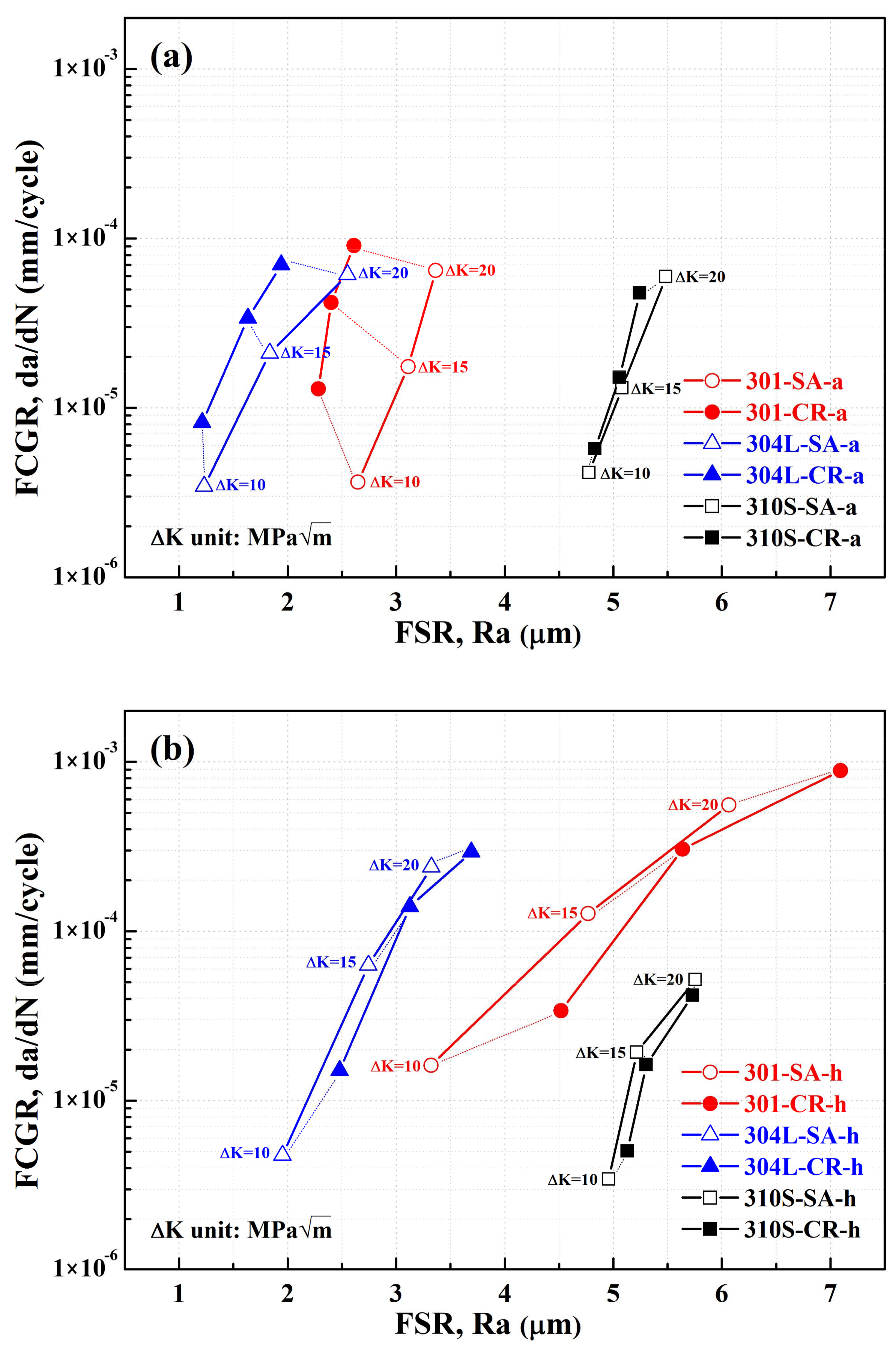
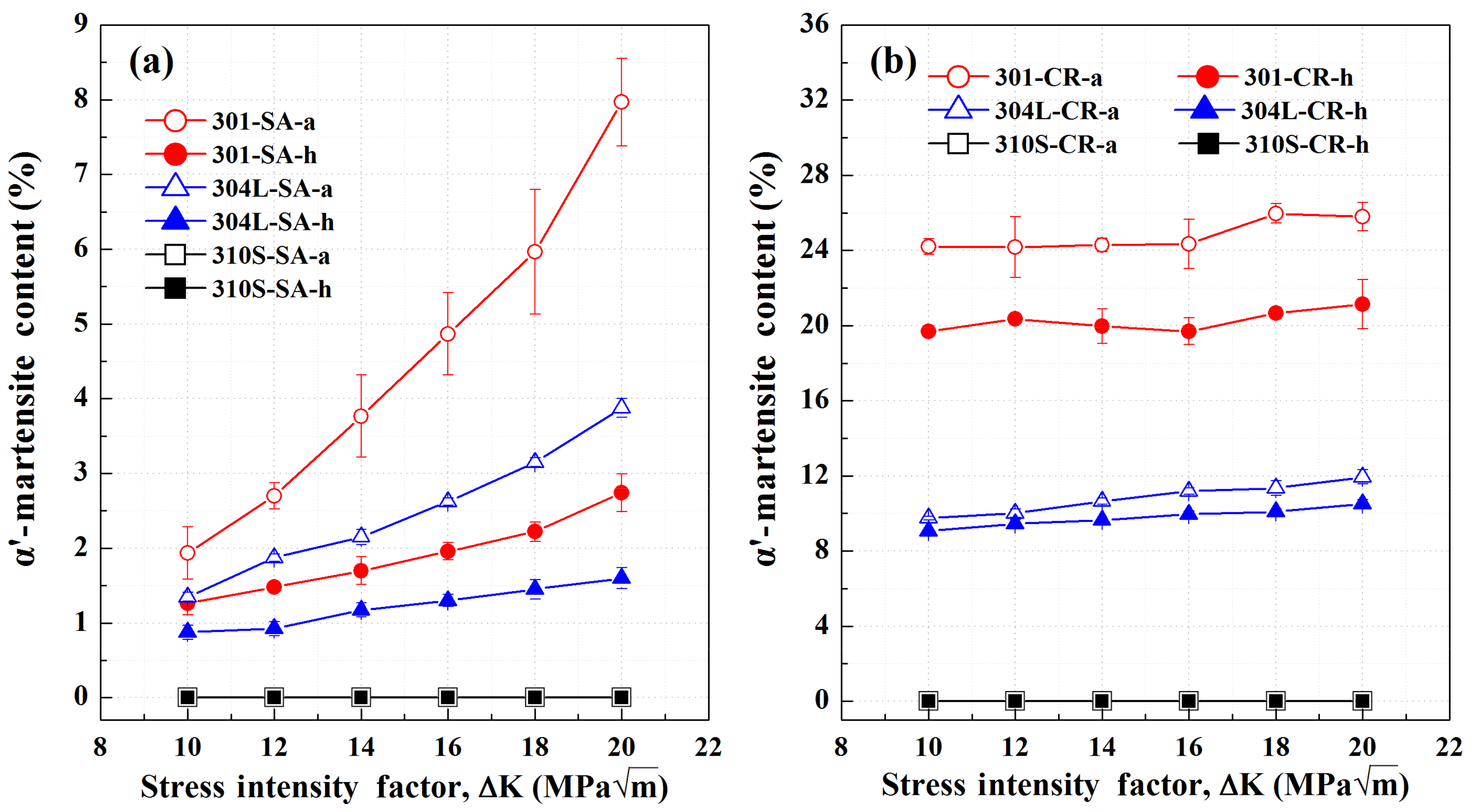
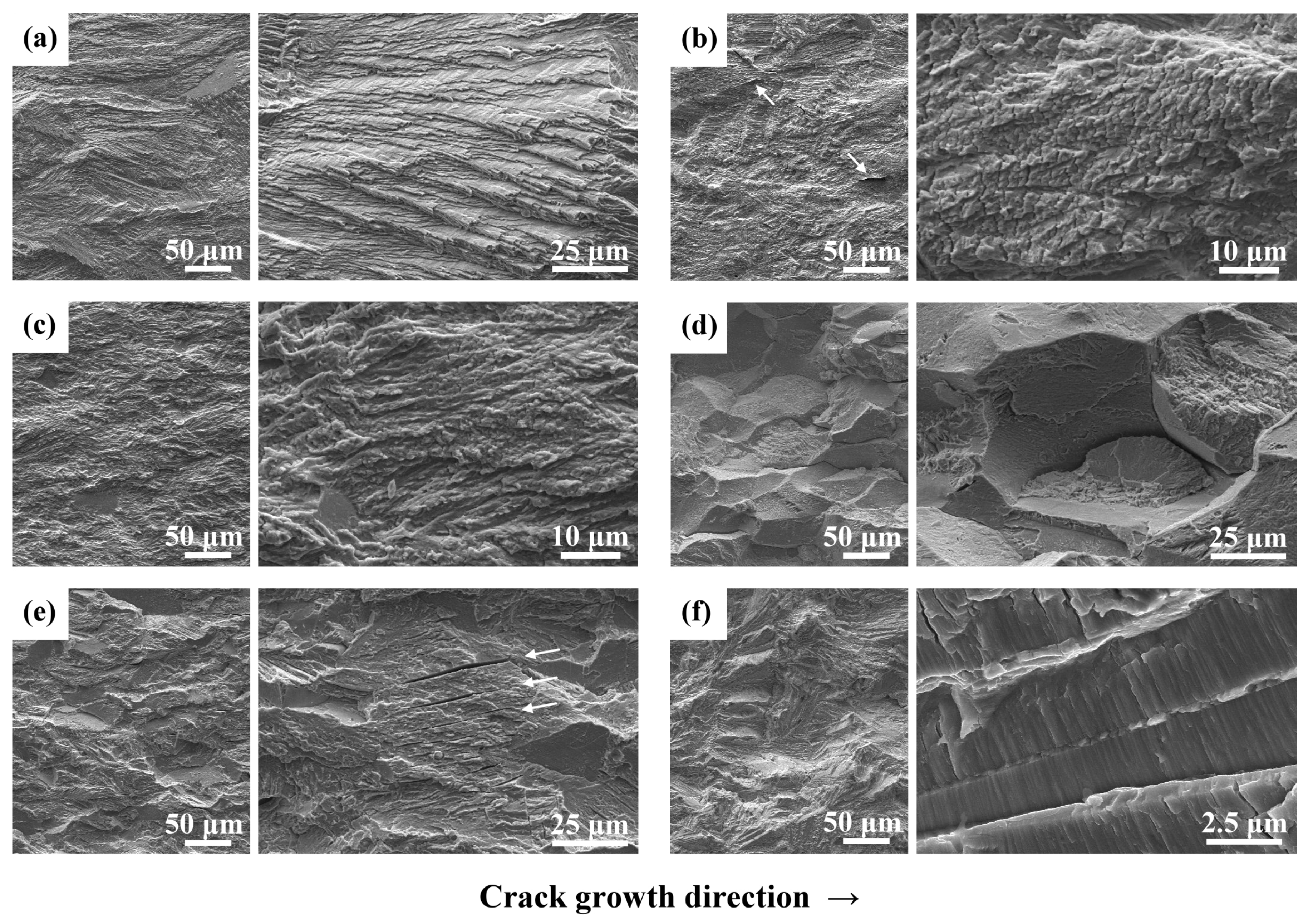
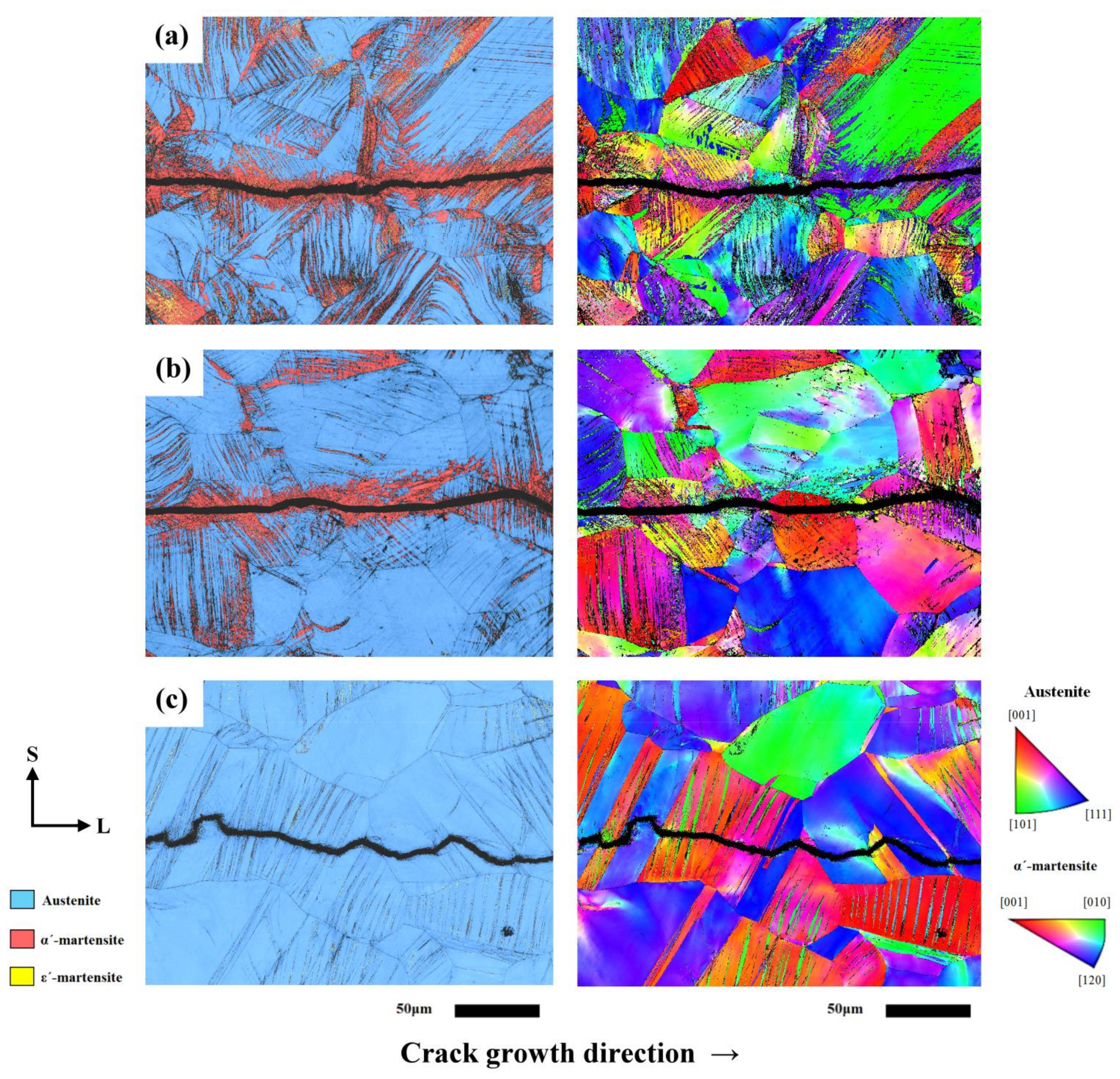

| Material | Chemical Composition (wt. %) | ||||||||
|---|---|---|---|---|---|---|---|---|---|
| C | Mn | Si | S | P | Cr | Ni | N | Fe | |
| 301 | 0.08 | 1.16 | 0.54 | 0.003 | 0.020 | 16.71 | 6.89 | - | bal. |
| 304L | 0.02 | 1.58 | 0.37 | 0.002 | 0.032 | 18.20 | 8.04 | 0.045 | bal. |
| 310S | 0.05 | 1.17 | 0.80 | 0.003 | 0.015 | 24.66 | 19.09 | - | bal. |
| Material | Condition | Testing Environment | |
|---|---|---|---|
| Air | Gaseous Hydrogen | ||
| 301 | SA | 301-SA-a | 301-SA-h |
| CR | 301-CR-a | 301-CR-h | |
| 304L | SA | 304L-SA-a | 304L-SA-h |
| CR | 304L-CR-a | 304L-CR-h | |
| 310S | SA | 310S-SA-a | 310S-SA-h |
| CR | 310S-CR-a | 310S-CR-h | |
© 2018 by the authors. Licensee MDPI, Basel, Switzerland. This article is an open access article distributed under the terms and conditions of the Creative Commons Attribution (CC BY) license (http://creativecommons.org/licenses/by/4.0/).
Share and Cite
Chen, T.-C.; Chen, S.-T.; Tsay, L.-W.; Shiue, R.-K. Correlation between Fatigue Crack Growth Behavior and Fracture Surface Roughness on Cold-Rolled Austenitic Stainless Steels in Gaseous Hydrogen. Metals 2018, 8, 221. https://doi.org/10.3390/met8040221
Chen T-C, Chen S-T, Tsay L-W, Shiue R-K. Correlation between Fatigue Crack Growth Behavior and Fracture Surface Roughness on Cold-Rolled Austenitic Stainless Steels in Gaseous Hydrogen. Metals. 2018; 8(4):221. https://doi.org/10.3390/met8040221
Chicago/Turabian StyleChen, Tai-Cheng, Sheng-Tsan Chen, Leu-Wen Tsay, and Ren-Kae Shiue. 2018. "Correlation between Fatigue Crack Growth Behavior and Fracture Surface Roughness on Cold-Rolled Austenitic Stainless Steels in Gaseous Hydrogen" Metals 8, no. 4: 221. https://doi.org/10.3390/met8040221





